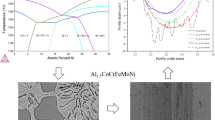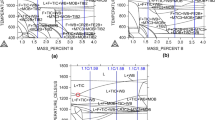Conclusion
An increase in the ultimate breaking strength, stress-rupture strength, and fatigue limit of alloy VT3-1 with a lamellar structure may be achieved as a result of refining any parameter of the structure, particularly α-phase platelet thickness, and increasing the volume fraction of secondary α-phase. An increase in ductility characteristics, toughness, and creep resistance may be provided by increasing the dimensions of α-colonies and primary α-phase particles (up to 2.5–3.5 μm) and reducing the volume fraction and dispersivity of secondary α-phase lamellar precipitates. Coarsening of β-grains leads to an increase in ac, kQ, and refinement leads to an increase in ψ and an.
Qualitative dependences for mechanical properties of alloy VT3-1 on lamellar structure parameters made it possible to isolate those structural parameters which have the most marked effect on properties.
The properties of alloys with a finely lamellar structure (d≤25 μm, bαI, αII<2 μm) are most sensitive to structure. In this case a change in α-colony size by 10 μm and α-platelet thickness by 1 μm affects the properties 3–20 times more strongly than a change in β-grain size by 100 μm. The effect of finely dispersed secondary α-phase precipitates is greater, the coarser the primary α-phase structure. Refinement of primary α-phase structure with an increase in secondary phase platelet thickness to 1 μm or more reduces the sensitivity of alloy mechanical properties to the effect of secondary α-phase.
With coarsening of the intragranular structure (d>25 μm, bαI, αII≥2 μm) the effect of structural parameters d and b on properties is markedly weakened: on strength properties (σf, σ 450100 ) by a factor of 100, on ductility (σ, ψ), by a factor of 10 to 20, and on impact strength and fracture toughness (an, ac, KQ) by a factor of five.
The qualitative relationships obtained between structure and mechanical properties of alloy VT3-1 are fundamental for controlling the structure of semifinished titanium alloy products.
Similar content being viewed by others
Literature cited
M. Ya. Brun, "Possibilities for improving the mechanical properties of titanium alloys by optimizing structure," Metalloved. Term. Obrab. Met., No. 11, 51–55 (1979).
V. K. Aleksandrov, N. F. Anoshkin, G. A. Bochvar, et al., Titanium Alloy Semifinished Products [in Russian], Metallurgiya, Moscow (1979).
E. A. Borisova, G. A. Bochvar, N. Ya. Brun, et al., Metallography of Titanium Alloys [in Russian], Metallurgiya, Moscow (1980).
G. V. Shakhanova and M. Ya. Brun, "Structure of titanium alloys and methods of its control," Metalloved. Term. Obrab. Met., No. 7, 19–22 (1982).
M. Ya. Brun, G. V. Shakhanova, I. V. Soldatenko, and V. L. Rodionov, "Effect of globular structure parameters on the mechanical properties of alloy VT3-1," Metalloved. Term. Obrab. Met., No. 5, 46–49 (1984).
M. Ya. Brun, N. Z. Pertsovskii, G. V. Shakhanova, and V. L. Rodionov, "Mechanical properties of titanium alloys in relation to lamellar structure parameters", in: Proc. 3rd Int. Conf. on Titanium, Vol. 3 [in Russian], VILS, Moscow (1978).
Additional information
Translated from Metallovedenie i Termicheskaya Obrabotka Metallov, No. 7, pp. 52–55, July, 1986.
Rights and permissions
About this article
Cite this article
Brun, M.Y., Shakhanova, G.V. & Soldatenko, I.V. Effect of lamellar structure parameters on the properties of titanium alloy VT3-1. Met Sci Heat Treat 28, 519–522 (1986). https://doi.org/10.1007/BF00780646
Issue Date:
DOI: https://doi.org/10.1007/BF00780646




